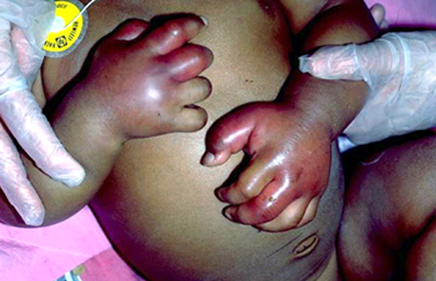Sickle cell anaemia

Objective
At the end of this PDF Notes, student will be able to
• Explain Sickle cell anaemia
• Describe the pathogenesis of Sickle Cell Anaemia and Clinical features of it
• Treatment of sickle cell anaemia
Sickle Cell Anaemia
• Sickle-cell disease (SCD), or sickle-cell anaemia or drepanocytosis, is an autosomal co-dominant
genetic blood disorder characterized by red blood cell that assume an abnormal, rigid, sickle shape.
Haemoglobinopathies: Haemoglobin in RBCs may be abnormally synthesised due to inherited defects. These disorders may be of two types:
• Qualitative disorders e.g. sickle cell syndrome, other haemoglobinopathies.
• Quantitative disorders e.g. thalassaemias.
Sickle syndromes occur in 3 different forms:
• 1. As heterozygous state for HbS: sickle cell trait (AS).
• 2. As homozygous state for HbS: sickle cell anaemia (SS).
• 3. As double heterozygous states e.g. sickle β-thalassaemia, sickle-C disease (SC), sickle-D disease (SD).
• Sickle cell anaemia (SS) is a homozygous state of HbS in the red cells in which an abnormal gene is inherited from each parent.
• Red blood cells typically live 90–120 days, but sickle cells only survive 10–20 days
Pathogenesis of Sickle cell anaemia
1. Basic molecular lesion: single point mutation in one amino acid out — there is substitution of valine for glutamic acid –
– 6-residue position of the β-globin, producing Hb α2β2s2.
2. Mechanism of sickling: During deoxygenation, the red cells containing HbS change from biconcave disc shape to an elongated crescent-shaped or sickle-shaped cell- sickling
• Form elongated rod-like polymers
• Which align and distort the red cell into classic sickle shape
3. Reversible-irreversible sickling
4. Factors determining rate of sickling:
• i) Presence of non-HbS haemoglobins
• ii) Intracellular concentration of HbS.
• iii) Total haemoglobin concentration.
• iv) Extent of deoxygenation.
• v) Acidosis and dehydration.
• vi) Increased concentration of 2, 3-BPG in the red cells.
Sickle Cell Anemia vs. Sickle Cell Trait
• People who have sickle cell anemia are born with it; means inherited, lifelong condition.
• They inherit two copies of sickle cell gene, one from each parent.
• Sickle cell trait is different from sickle cell anemia. People with sickle cell trait don’t have the condition, but they have one of the genes that cause the condition.
• People with sickle cell anemia and sickle cell trait can pass the gene on when they have children.
Inheritance of Sickle Cell Anemia
• If one parent has sickle cell anaemia (HbSS) and the other is completely unaffected (HbAA) then all the children will have sickle cell trait.
• None will have sickle cell anemia.
• The parent who has sickle cell anemia (HbSS) can only pass the sickle hemoglobin gene to each of their children.
• If both parents have sickle cell trait (HbAS) there is a one in four (25%) chance that any given child could be born with sickle cell anemia.
• There is also a one in four chance that any given child could be completely unaffected.
• There is a one in two (50%) chance that any given child will get the sickle cell trait.
Clinical Features of Sickle Cell Anemia
• Painful episodes
• Pneumococcal disease
• Acute chest syndrome
• Splenic infarction
• Splenic sequestration
• Stroke
• Osteonecrosis
• Priapism
• Retinopathy
• Leg ulcers
• Gallstones
• Renal abnormalities
• Osteopenia
• Nutritional deficiencies
• Placental insufficiency
• Pulmonary hypertension
| Associated with higher hemoglobin | Associated with lower hemoglobin |
| Painful episodes | Stroke |
| Acute chest syndrome | Priapism |
| Osteonecrosis | Leg Ulcers |
| Proliferative retinopathy |
Complications of Sickle Cell Disease
Sickle Cell – Avascular Necrosis
Sickle Cell – Dactylitis
Sickle Cell Anemia – Treatment
• Opiates and hydration for painful crises
• Pneumococcal vaccination
• Retinal surveillance
• Transfusion for serious manifestations (eg stroke); exchange transfusion
• Hydroxyurea
• Stem cell transplant
Treatment of Sickle cell anaemia
Effective treatments are available to help relieve the symptoms and complications of sickle cell anemia, but in most cases there’s no cure.
The goal is to relieve the pain; prevent infections, eye damage, strokes and control complications if they occur.
Pain medicine: acetaminophen, nonsteroidal anti-inflammatory drugs (NSAIDs), and narcotics such as meperidine, morphine, oxycodone, and etc.
Heating pads
Hydroxyurea, Folic Acid
Blood Transfusions
Prevention of Sickle cell anaemia
Identify what can trigger the “Crisis” such as stress, avoid extremes of heat and cold weather, don’t travel airplane that is not cabin pressurized
Maintain healthy lifestyle habits
÷ Eating healthy
÷ Avoid dehydration
÷ Exercise regularly
÷ Get enough sleep and rest
÷ Avoid alcohol and don’t smoke
Regular medical checkups and treatment are important
Summary
• Sickle-cell disease (SCD), or sickle-cell anaemia or drepanocytosis, is an autosomal co-dominant genetic blood disorder characterized by red blood cell that assume an abnormal, rigid, sickle shape.
• Pathogenesis: Basic molecular lesion, Mechanism of sickling, Reversible-irreversible sickling,Factors determining rate of sickling
• Sickle cell trait is different from sickle cell anemia. People with sickle cell trait don’t have the condition, but they have one of the genes that cause the condition





